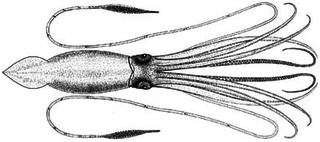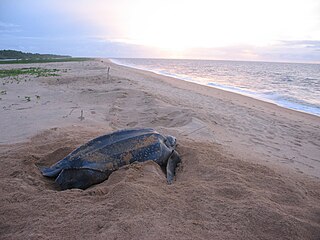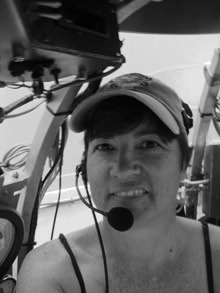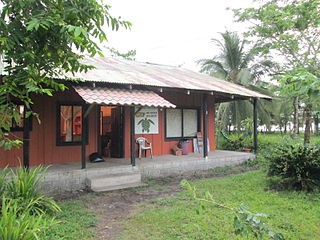
Sea turtles, sometimes called marine turtles, are reptiles of the order Testudines and of the suborder Cryptodira. The seven existing species of sea turtles are the flatback, green, hawksbill, leatherback, loggerhead, Kemp's ridley, and olive ridley. Six of the seven sea turtle species, all but the flatback, are present in U.S. waters, and are listed as endangered and/or threatened under the Endangered Species Act. All but the flatback turtle are listed as threatened with extinction globally on the IUCN Red List of Threatened Species. The flatback turtle is found only in the waters of Australia, Papua New Guinea, and Indonesia.

The giant squid is a species of deep-ocean dwelling squid in the family Architeuthidae. It can grow to a tremendous size, offering an example of abyssal gigantism: recent estimates put the maximum size at around 12–13 m (39–43 ft) for females and 10 m (33 ft) for males, from the posterior fins to the tip of the two long tentacles. The mantle of the giant squid is about 2 m long, and the length of the squid excluding its tentacles rarely exceeds 5 m (16 ft). Claims of specimens measuring 20 m (66 ft) or more have not been scientifically documented.

The leatherback sea turtle, sometimes called the lute turtle, leathery turtle or simply the luth, is the largest of all living turtles and the heaviest non-crocodilian reptile, reaching lengths of up to 2.7 metres and weights of 500 kilograms (1,100 lb). It is the only living species in the genus Dermochelys and family Dermochelyidae. It can easily be differentiated from other modern sea turtles by its lack of a bony shell; instead, its carapace is covered by oily flesh and flexible, leather-like skin, for which it is named. Leatherback turtles have a global range, although there are multiple distinct subpopulations. The species as a whole is considered vulnerable, and some of its subpopulations are critically endangered.

A drinking straw is a utensil that is intended to carry the contents of a beverage to one's mouth. Disposable straws are commonly made from plastics. However, environmental concerns related to plastic pollution and new regulation have led to rise in reusable and biodegradable straws. Following a rise in regulation and public concern, some companies have even voluntarily banned or reduced the number of plastic straws used. Alternative straws are often made of reusable materials like silicone or metal or alternative disposable and biodegradable materials like paper, cardboard, pasta, or bamboo.

The olive ridley sea turtle, also known commonly as the Pacific ridley sea turtle, is a species of turtle in the family Cheloniidae. The species is the second-smallest and most abundant of all sea turtles found in the world. L. olivacea is found in warm and tropical waters, primarily in the Pacific and Indian Oceans, but also in the warm waters of the Atlantic Ocean.

Las Baulas de Guanacaste Marine National Park is a National Park of Costa Rica and a Ramsar Site. The park is managed by the Tempisque Conservation Area, and covers approximately a 167.3 square kilometres (64.6 sq mi) marine area of the Tamarindo Bay, next to the town of Tamarindo. It supports the largest nesting colony of leatherback sea turtles on the Pacific coast of the Americas. Female leatherbacks often come ashore at Playa Grande between October and May to lay their eggs.
Ostional Mixed Wildlife Refuge, is an 85.7 km2 (33.1 sq mi) Wildlife refuge of Costa Rica, part of the Tempisque Conservation Area, was originally declared a protected area in 1982, and its status has been changed several times since then, including covering a larger area both on land and out to sea. It was created to protect important nesting beaches of the Olive ridley sea turtle.

The Nicoya Peninsula is a peninsula on the Pacific coast of Costa Rica. It is divided into two provinces: Guanacaste Province in the north, and the Puntarenas Province in the south. It is located at 10°N 85.4166667°W. It varies from 19 to 37 miles (60 km) wide and is approximately 75 miles (121 km) long, forming the largest peninsula in the country. It is known for its beaches and is a popular tourist destination.
Xeko is an out-of-print collectible card game revolving around endangered species. It was launched on Earthday 2006. It won the Creative Child Magazine 2006 Toy of the Year Award and the National Parenting Center's Seal of Approval in its first year. Four "Mission" sets have been released. Mission: Costa Rica and Mission: Madagascar, based on biodiversity hotspots were released first. Mission: Indonesia, was released in 2007, with the final release, Mission: China, was released July 19, 2008. A total of thirty more missions were planned but never developed.

Nosara is a district of the Nicoya canton, in the Guanacaste province of Costa Rica.

Galibi is a resort in Suriname, located in the Marowijne District. Its population at the 2012 census was 741. Galibi is a tribal area inhabited by an indigenous population of Kalina Amerindians.

Edith Anne "Edie" Widder Smith is an American oceanographer, marine biologist, author and the Co-founder, CEO and Senior Scientist at the Ocean Research & Conservation Association.
Ecology Project International is a non-profit organization based in Missoula, Montana, dedicated to developing place-based, ecological education partnerships between local experts and youth to address conservation issues. Ecology Project International (EPI) works with students and educators at seven program sites around the world: Belize, Costa Rica, mainland Ecuador, Galápagos Islands, Hawaii, Mexico, and Yellowstone.

Threats to sea turtles are numerous and have caused many sea turtle species to be endangered. Of the seven extant species of sea turtles, six in the family Cheloniidae and one in the family Dermochelyidae, all are listed on the IUCN Red List of Endangered Species. The list classifies six species of sea turtle as "threatened", two of them as "critically endangered", one as "endangered" and three as "vulnerable". The flatback sea turtle is classified as "data deficient" which means that there is insufficient information available for a proper assessment of conservation status. Although sea turtles usually lay around one hundred eggs at a time, on average only one of the eggs from the nest will survive to adulthood. While many of the things that endanger these hatchlings are natural, such as predators including sharks, raccoons, foxes, and seagulls, many new threats to the sea turtle species are anthropogenic.

Michael V. deGruy was an American documentary filmmaker specializing in underwater cinematography. His credits include Life in the Freezer, Trials of Life, The Blue Planet and Pacific Abyss. He was also known for his storytelling, including a passionate TED talk about his love of the ocean on the Mission Blue Voyage. His company, Film Crew Inc., specialized in underwater cinematography, filming for the BBC, PBS, National Geographic, and the Discovery Channel. His notable accomplishments include diving beneath thermal vents in both the Atlantic and Pacific oceans. He was a member of many deep sea expeditions and was a part of the team that first filmed the vampire squid and the nautilus.

Asociación Salvemos las Tortugas de Parismina (Spanish), is a community-based, non profit, conservation organization based in Parismina, Costa Rica, dedicated to protecting sea turtles and their eggs from poaching while initiating sustainable development and providing a viable alternative economy to poaching in the village.
The Leatherback Trust is a non-profit organization dedicated to the conservation and study of sea turtles and freshwater turtles, with special regard for the leatherback sea turtle. The Leatherback Trust was founded in 2000 to help consolidate Las Baulas National Marine Park, one of the last major nesting site for the critically endangered leatherback turtle in the Eastern Pacific Ocean. The park protects Playa Grande, Playa Ventanas, Playa Langosta, the ocean out to 12 nautical miles, wetlands, highlands, and the coast inland to 125 m from the high tide line.

The Costa Rica Thermal Dome, is an oceanographic feature and marine biodiversity hotspot that varies in size from 300 to 1,000 km in diameter. The dome is located off the western coast of Central America in the Tropical Eastern Pacific. Through the interaction of wind and ocean currents, deeper waters are drawn towards the surface in a dome-like shape at this location. These waters displace the warmer, nutrient-poor waters with colder, nutrient-richer waters. An investigation by UNESCO'S World Heritage Site and International Union for Conservation of nature (IUCN) in 2016 considered it eligible to become a World Heritage Site in the near future.

Christine Figgener is a German marine conservation biologist, author, science communicator, and ocean advocate recognized for her work in sea turtle conservation, the fight against plastic pollution, and the empowerment of women in STEM. She is best known for documenting the removal of a plastic straw from a sea turtle's nose in a YouTube video that went viral in 2015. This video, which was featured in popular media outlets such as National Geographic, HuffPost, The New York Times, ABC News, and CNN, highlighted the dangers of plastic pollution on marine wildlife and was a catalyst for the global anti-straw movement that led to several straw bans by businesses such as Starbucks, Disney, and Alaska Airlines.















